The Incomplete Wolverine: 1980
Part 1: Origin to Origin II | Part 2: 1907 to 1914
Part 3: 1914 to 1939 | Part 4: World War II
Part 5: The postwar era | Part 6: Team X
Part 7: Post Team X | Part 8: Weapon X
Part 9: Department H | Part 10: The Silver Age
1974-1975 | 1976 | 1977 | 1978 | 1979
This is a big year, as the X-Men enter the 1980s with the Dark Phoenix Saga – the storyline that elevated them into A-listers. After this year, other writers will have a lot more interest in using the X-Men. But we’ve got to get there first.

X-MEN vol 1 #129 (part 1)
“God Spare the Child…”
by Chris Claremont, John Byrne, Terry Austin & Bob Sharen
January 1980
After a few days recuperating on Muir Isle following their fight with Proteus, the X-Men set off home (leaving behind Banshee, who finally quits the team). Professor X is waiting for them – he’s come back because he’s worried about Phoenix losing control, though he doesn’t explain that to the team just yet.
At this point, there’s a break in the action for the X-Men to do some training. A few other appearances fit in here.
First, Uncanny X-Men vol 1 #187 has a flashback where Wolverine teaches Storm how to shoot. He argues that it’ll give her an edge, because nobody will expect it. To be honest, this could go pretty much anywhere. The official chronology has it between issues #147-148, but it reads to me like Storm isn’t team leader yet, so I’m putting it here.

CLASSIC X-MEN #39 (backup story)
“Briggs’ Revenge”
by Ann Nocenti, Jim Lee, Joe Rubinstein & Gregory Wright
November 1989
When Storm snubs mutant Billy Briggs, he tails her back to the Mansion (surprisingly easily) and forces Storm to choose whether he kills Colossus or Wolverine with his disintegration power. Storm chooses Wolverine, because she rightly figures that he’ll survive – but Wolverine is still upset about it, and Billy takes that as a victory. A nice character moment, though with some dodgy plotting to get there.
A flashback in Super Soldiers #7 also goes in this gap. It’s an obscure Marvel UK tail-end title from 1993, which was cancelled one issue later. As part of the origin of team member Guvnor (Andy Black), the X-Men show up at his family’s council flat to try to recruit him. Xavier’s condescendingly patrician pitch goes down very badly indeed with the locals. It’s a parody of Kitty Pryde’s recruitment, and obviously meant to take place at around the same time.

X-MEN vol 1 #129 (part 2) to #131
“God Spare the Child…” / “Dazzler” / “Run for Your Life!”
#129 by Chris Claremont, John Byrne, Terry Austin & Bob Sharen
#130-131 by Chris Claremont, John Byrne, Terry Austin & Glynis Wein
January to March 1980
Wolverine is, quite reasonably, infuriated by Professor X’s training style. But before that can go anywhere, the X-Men split up to investigate two new mutants. Logan joins Xavier, Ororo and Peter in going to Chicago, where they meet 13-year-old Kitty Pryde.
Logan’s met Kitty before in a time travel story, but he doesn’t remember that, for the usual reasons. More problematically, neither he nor Xavier shows any signs of recognising Kitty’s father Carmen Pryde, or vice versa – despite Chris Claremont’s attempts years later to give them a shared military career. There’s no way of making those later scenes work unless you take them as a hard retcon that overrides the original story. Anyway… whatever view you take of all that, this is also where Logan meets Kitty’s mother Terri Pryde.

The four X-Men are attacked and captured by Hellfire Club soldiers working for Emma Frost, and Kitty stows away when they’re taken to a Hellfire Club base. Storm gives Kitty the contact details for the other X-Men, who duly show up along with their own new mutant Dazzler (Alison Blaire). The prisoners are rescued, and Phoenix defeats the White Queen in a high-powered psychic battle that brings the building down. Phoenix says outright that Emma is dead, but she’ll show up alive and well in due course. Afterwards, Dazzler declines to join the team, but Phoenix telepathically “persuades” Kitty’s parents to sign their daughter up. Kitty won’t arrive at the school for a few issues yet, though.
These issues focus on Kitty and Dazzler, and Logan’s barely in issue #130 at all. But they do have the first glimpses of Logan and Kitty together. Naturally, she’s intimidated by him. He’s instantly protective of her, but not to the point of actually wanting to talk to her. It’s strongly implied that he kills two guards when they hurt her, by way of retaliation.
The expansion pack for this story…
- A flashback in issue #132 has a bit more of the X-Men’s capture.
- The back-up strip in Classic X-Men #35 is a Kitty Pryde story in which she hallucinates before gathering her senses to follow the captured X-Men; Wolverine’s in one panel.
- X-Men: Origins – Emma Frost has a scene showing Wolverine and the others as prisoners.
- Dark X-Men: The Confession #1 has a flashback to the same effect.

X-MEN vol 1 #132 (part 1)
“And Hellfire Is Their Name!”
by Chris Claremont, John Byrne, Terry Austin & Glynis Wein
April 1980
Hoping to throw the Hellfire Club off the track, the X-Men retreat to Warren Worthington III’s home in New Mexico (where they also meet Warren’s girlfriend Candy Southern). There’s a break in the action here, where Scott and Jean/Phoenix establish their psychic rapport. That break seems to be the only viable place to put…
GIRL COMICS vol 2 #1
“Head Space”
by Devin Grayson, Emma Rios & Barbara Ciardo
March 2010

Cyclops has a nightmare about the chaos that seems to follow in Wolverine’s wake, what with all the people hunting for him. Through her psychic link, Jean assures him she only has eyes for him, so there’s no reason to worry about her and Logan. Nobody seems entirely convinced. (This story doesn’t fit neatly anywhere, since Scott imagines Logan being pursued by the Hand, and it’s way too early for anyone to be thinking of them. But if it’s Scott and Jean, and they’ve got a psychic rapport, it has to go here.)
X-MEN vol 1 #132 (part 2) to #134
“…And Hellfire Is Their Name!” / “Wolverine: Alone!” / “Too Late, the Heroes!”
by Chris Claremont, John Byrne, Terry Austin & Glynis Wein
April to June 1980
Back to the main event. The X-Men return to New York to break into the Hellfire Club during its Anniversary Ball. They fight the rest of the Club’s Inner Circle – mutants Sebastian Shaw and Harry Leland, cyborg Donald Pierce, and probationary member Jason Wyngarde (better known as Mastermind – Wolverine’s met him before in that guise in Marvel Holiday Speical 1991). Leland uses his mass-control powers to send Wolverine crashing through the floor into the storm drains. Everyone else gets capture, and Wyngarde’s brainwashing briefly turns Phoenix into the Black Queen.
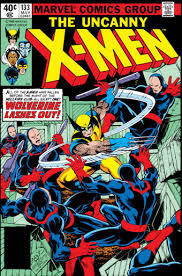
This leads to Wolverine’s big spotlight issue, as he returns to the Club alone to save his teammates. To be honest, purely in plot terms, it’s debatable how much difference he actually makes – Phoenix is breaking free anyway by the time he reaches her. But this is one of the iconic Wolverine stories, as he finally gets to do his thing without the other X-Men holding him back. And by this point, that means that he outwits the bad guys as well as outfighting them – and comes across as a force of nature in the process.
He starts by tearing apart the Hellfire Club soldiers in the basement. Three of these henchmen are Wade Cole, Angelo Macon and Murray Reese, and they’ll return as cyborgs years down the line, eventually winding up as members of the Reavers. After getting past them, Wolverine fights his way right through the public party, making a wonderful first impression on partygoers such as Senator Robert Kelly. He does hold back against the regular Club staff, who are just ordinary security guards – but only because he figures that “carving them up could create more hassles than it solves”.

And he reaches the rest of the X-Men in time to help them defeat the Inner Circle and escape. In that closing fight, Wolverine leaps on Leland, who rather foolishly uses his powers in response. Of course, that just makes Wolverine land on him even harder. The very strong implication in the original story is that Wolverine kills Leland, but the story stops just short of saying so. In the end, Leland will just turn up again without any explanation beyond “he got better”.
Unfortunately, just as the Blackbird takes off, Phoenix finally snaps for good. She becomes Dark Phoenix and turns on the X-Men. But more of that later.
As you might expect from a seminal story, there’s an expansion pack:
- A flashback in Wolverine / Hercules: Miracles, Myths & Monsters #1 shows more of Wolverine’s fight with Cole, Macon and Reese. The Olympian gods watch from afar with admiration.
- Code of Honor #2 shows the aftermath of the encounter with the Hellfire Club, and the manifestation of Dark Phoenix, from the perspective of the police officers below.
- In the second story in Iron Age #3 (published 2011), in the middle of their final fight with the Inner Circle, the X-Men stumble upon Iron Man (Tony Stark) being held prisoner in the Hellfire Club. This Iron Man has travelled back in time from the present day of 2011 for convoluted reasons that involve stopping a villain from harnessing Dark Phoenix’s power, and he has a half-hearted stab at changing history, without success. It’s a real stretch to shoehorn this into Uncanny #134, but there it is.

X-MEN vol 1 #135-137
“Dark Phoenix” / “Child of Light and Darkness!” / “The Fate of the Phoenix!”
by Chris Claremont, John Byrne, Terry Austin & Glynis Wein
July to September 1980
Dark Phoenix easily defeats the X-Men and heads off to do destructive cosmic stuff. When she finally returns to Earth to menace her parents and her sister Sarah Grey, the X-Men (plus Angel and Beast) nearly manage to subdue her with a scrambler device. Cyclops talks her down, and Professor X psychically defeats her – only for the X-Men, Angel and Beast to get teleported away by the Shi’ar so that Phoenix can stand trial for committing genocide during her cosmic jaunt. The X-Men decide that Phoenix wasn’t in her right mind, and demand a trial by combat. In the trial, the X-Men fight the Imperial Guard (now including new members Warstar, Hussar and Earthquake. During the fight, Wolverine stumbles into the home of Uatu the Watcher, who dazzles him with a display of time travel before booting him out. Then Wolverine gets attacked by the supposedly impartial Kree and Skrull observers, Raksor and Bel-Dann. Finally, the X-Men are defeated, and Jean commits suicide to prevent herself from turning into Dark Phoenix again.

Obviously, the focus is off Wolverine in these issues. He refuses to give up in the face of overwhelming odds, but more because he wants to go down fighting than because he actually thinks the X-Men can win. He also regards himself as the only X-Man willing to kill Dark Phoenix if the opportunity presents itself – but in reality, he hesitates too when he thinks the real Jean might be coming back. More significantly, when the individual X-Men get their character scenes as they prepare for the trial, Logan is seen calmly meditating. He thinks that Jean and Phoenix are two separate personalities and thinks that he’s uniquely placed to understand that – there’s a suggestion that he sees his own violent rages as analogous.
Again, given how Logan and Jean’s relationship was played with hindsight, there’s remarkably little emphasis here on any attraction (even unrequited). It would probably have got in the way of a story that’s basically about Jean and Scott. Wolverine does say near the end that he “loved” Jean – he hesitates before “loved”, though it’s unclear whether that’s because he’s stumbling over the past tense or the mere fact of admitting his feelings in front of the other X-Men. At any rate, it’s a single moment, and feels more like an acknowledgement of a past storyline.
The expansion pack:
- A flashback in X-Men Unlimited vol 2 #9 has more of Wolverine’s fight with Warstar.
- Wolverine’s fight with the Kree and Skrull observers is also shown in the prologue to Fantastic Four Annual #18.
On returning to Earth, the X-Men visit Jean’s family and break the news of her death, as seen in flashback in Uncanny X-Men vol 1 #199.
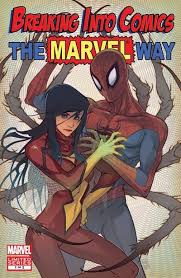
BREAKING INTO COMICS THE MARVEL WAY! #1
“Let it Out”
by Chris Yost, Paul Davidson and Chris Sotomayor
March 2010
This was a new-talent anthology pairing new artists with established writers. At Wolverine’s suggestion, the male X-Men (and Havok) have a sparring session to help Cyclops let out his pent-up emotions over Jean’s death. It ends with the X-Men carrying Jean’s coffin into her funeral.
For some reason this issue isn’t on Marvel Unlimited (though issue #2 is). You can buy it from Comixology if you really want, though.
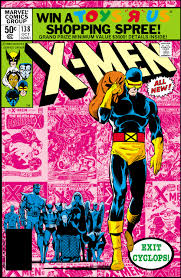
X-MEN vol 1 #138
“Elegy”
by Chris Claremont, John Byrne, Terry Austin & Glynis Wein
October 1980
Jean’s funeral. Scott reminisces about Jean, and recaps the whole series to date in the process – it’s basically a clip show, which made a bit more sense in the days when reprints and back issues weren’t readily available. Afterwards, he leaves the team. Meanwhile, Kitty Pryde moves into the Mansion. (Or she would, if anyone was there to let her in.)
A flashback in Wolverine: Weapon X #16 takes place shortly after the funeral. Logan sits and drinks by Jean’s grave. Kurt offers faith-based condolences, and Logan doesn’t want to hear them. Kurt replies that they can talk about it another time.
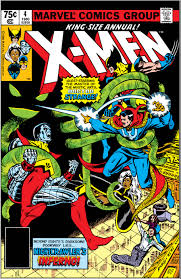
X-MEN ANNUAL vol 1 #4
“Nightcrawler’s Inferno”
by Chris Claremont, John Romita Sr, Bob McLeod & Glynis Wein
1980
When Nightcrawler’s soul is stolen, the X-Men team up with Doctor Strange to rescue him from what seems to be Hell. It’s actually a pocket dimension created by his adoptive mother, sorceress Margali Szardos, who blames him for killing her son Stefan (just before Giant-Size X-Men #1). The encounter has been engineered by Margali’s daughter Jimaine Szardos, who has been posing as Nightcrawler’s girlfriend Amanda Sefton all along. The family are duly reconciled when Margali learns that Nightcrawler only killed Stefan by accident while trying to stop his killing spree.
The story is basically “the X-Men visit Dante’s Inferno”. Wolverine seems remarkably unfazed by the whole thing, and he and Colossus – the two team atheists – do question whether the punishments in Hell are remotely proportionate to the crime. At the end, Wolverine is the one who makes an effort to bring Kitty into the celebrations and reassure her that she’s an X-Man (even though she didn’t go on the adventure).
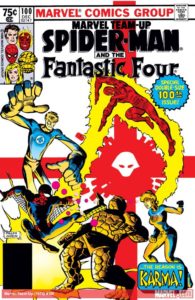
MARVEL TEAM-UP vol 1 #100
“Karma!”
by Chris Claremont, Frank Miller, Bob Wiacek & Carl Gaffod
December 1980
Wolverine is among the X-Men whose training session is interrupted when Mr Fantastic phones up to ask for help with a new mutant. It’s Karma, but Wolverine won’t meet her until she joins the New Mutants, and that’s still a while away.
At around this point, the Angel rejoins the X-Men.
WOLVERINE: FIRST CLASS #1
“The Buddy System”
by Fred Van Lente & Andrea Di Vito
March 2008
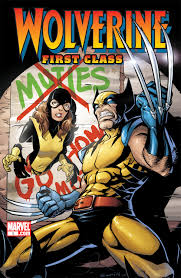
In folk-memory, Wolverine and Kitty had a mentor/sidekick relationship in the 80s, similar to the one he had in the early nineties with Jubilee. That… didn’t really happen. Kitty was the junior member of the whole team; there weren’t many Wolverine solo stories in those days. Yes, there’s the Kitty Pryde & Wolverine mini, but that’s one story, and they’re separated for most of it anyway.
At any rate, that leaves plenty of space for this series to tell all those Wolverine and Kitty team-up stories that everyone remembers but which never actually happened. Despite the title, it’s a Kitty Pryde & Wolverine ongoing. The Fred Van Lente run fits quite neatly into continuity, and it was plainly calculated to do so. The Peter David run which followed is another matter, but we’ll get to that.
It’s Kitty’s first proper day of classes. Cerebro detects an exceptionally powerful mutant in West Virginia, and Professor X sends Wolverine and Kitty to investigate, claiming that Kitty will benefit form working alongside the veteran. Wolverine tries his best to get rid of her, but she won’t have it. Together, they rescue Michelle, a panicking mutant with emotion-heightening powers, who sends Wolverine into a berserker rage until rookie Kitty manages to talk him down.
Afterwards, Wolverine accuses Professor X of endangering Kitty. Professor X argues that Wolverine needs to overcome his fear of close relationships, and that Kitty is the ideal person to help him do that. By the time of the epilogue, Logan is trying to bond with her with a bit of motocross. It’s a good issue that fits nicely with the distant, surly persona that Wolverine still had in X-Men at that time – and, of course, it establishes the premise for this series.
Michelle never gets a surname. Since it would strain continuity to breaking point for her to stay at the Mansion, she goes to Muir Isle, where she becomes the original Amp.
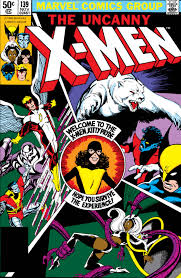
X-MEN vol 1 #139-140
“…Something Wicked This Way Comes!” / “Rage!”
by Chris Claremont, John Byrne, Terry Austin & Glynis Wein
November and December 1980
Wolverine has now switched to his new costume (which he declines to explain), Storm is team leader, and Kitty has taken the codename Sprite. Hoping to square things with Department H, Wolverine returns to Canada, with Nightcrawler tagging along for security. First they drop in on Heather Hudson; this leads to Kurt finally hearing the name “Logan”. Heather sends them to Hudson Bay, where Vindicator, Shaman and Snowbird are dealing with the Wendigo. (The rest of Alpha Flight are off on another mission, which appears in Machine Man vol 1 #19.) Wolverine and Nightcrawler help Alpha Flight to defeat the Wendigo, and Shaman turns him back into the human George Baptiste. Vindicator promises to sort things out with Department H, and the storyline of the Canadians trying to recover Wolverine is finally closed off.
Wolverine and Heather are played here as very close friends, in stark contrast to any relationship that he has with the X-Men – all the more so because the same scene establishes that his teammates still don’t know his real name, five years into the series. It also completely retcons away all those earlier stories where Claremont had Wolverine claiming that he had never had any friends before. He does switch to claiming that Heather and James were his only “true” friends, but it’s a huge shift in portrayal and makes Wolverine seem much more emotionally functional than he has in the past. The story tries to present this as Wolverine finally revealing his hidden depths, but in part he’s just being retconned into a deeper character.
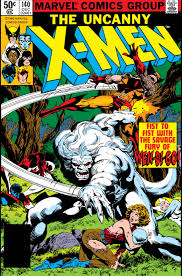
Since Baptiste voluntarily became the Wendigo in the first place (in order to take the curse off someone else), he’s carted off to face trial for his crimes as the monster. Nightcrawler raises the question of whether Wolverine ought to face responsibility for his own homicides. Wolverine’s answer is that he’s been a soldier and a secret agent, and he has no compunction about trying to kill people who are trying to kill him. More problematically, in the light of later stories, he insists that he’s only ever killed in self-defence. To make this work, you may have to take it as Wolverine telling Nightcrawler what he wants to hear.
Meanwhile, in a subplot, Angel voices his concerns about Wolverine to Professor X. Angel considers Wolverine dangerously mad; Professor X accepts that he has faults, but maintains that he has extraordinary potential. As we enter the 1980s, the book’s attitude to Wolverine has changed dramatically – he’s gone from being obnoxiously macho to a breakout character.
Finally, X-Men: Liberators #1 has a flashback of a nervous Sprite watching the X-Men in the Danger Room.
For completeness, if it’s canon, the story “Best There Is” from Deadpool’s Nerdy 30 #1 would have to go here (because it’s the earliest possible gap in which Wolverine is wearing the right costume). It’s a comedy story where Wolverine and some HYDRA agents fight their way into a school prom, and Wolverine winds up beating them with the unexpected assistance of teenager Wade Wilson, the future Deadpool. Although the issue contains some outright gag strips, there’s nothing obviously non-canon about this story in itself. The problem is that Deadpool’s Secret Secret Wars established that Wade was active as Deadpool by the time of Contest of Champions (which came out in 1982). So he’d have to join the army, drop out, become a mercenary, join Department K, get his powers, escape, and start working as Deadpool, all in about a year and half’s worth of Uncanny X-Men stories – which doesn’t really make sense.
Next time, 1981, and the X-Men start showing up in the wider Marvel Universe. (And, loads of Wolverine: First Class…)
Edited on 23 July 2021 to add the reference to Deadpool’s Nerdy 30.

Is there an in-universe reason for him changing to the much cooler brown costume?
I think he replies to a question about why he changed it with a ‘why not?’.
I guess he just thought it looked cooler. Rightly so.
It does look better, but #139 strongly hints that it is a homage to Jean, a token to remember her by. Kurt very emphatically thinks to himself that the setting sun makes the Canadian horizon take colors that remind him of Jean.
As it happens, those colors are very similar to Wolverine’s new costume’s. It always felt to me like one of those things that people see no need to highlight.
These last few issues are when Wolverine becomes the utterly uninteresting, utterly malleable wildcard character that he is to this day. Coherence of character is lost to him now, for good. He is just a tool for the plot to twist to its immediate convenience, previous characterization be darned.
More interestingly, Jimmy Hudson is also noticeably different from what he was in his previous appearances. His character is better established, he is far less resentful towards Wolverine, and less competitive as well. Accordingly, Wolverine also shows him a lot more respect than we would previously expect.
@Luis: What’s the defining break in your opinion? Not arguing, but we’ve seen the character change quite a lot in the span of a few years (rookie to veteran, for example) and just wondering where you draw the line between redefining Wolverine and running him.
Thanks for asking. It was actually in the late 1979 stories, during their confrontation against Proteus.
Wolverine was interesting when he was scarred by Proteus’ assault and was rescued by Scott and Jean.
That was his absolute zenith as a character. The overconfident, impulsive brat that suddenly learns too late that he can very much be well out of his league without any warning. Seeing him admit that Scott knew better and rescued him was a marvel of writing, a high point for Claremont as well as for Wolverine and even Scott.
Unfortunately, that was it. He simply never again reached those heights of characterization, which were very soon forgotten entirely.
In a way it is almost disturbing. He went on with the X-Men through the Hellfire Club stories, then the Dark Phoenix Saga and so on, rarely being away for long and even being given a four issue miniseries back in 1982.
To this day I have no idea of why that happened, and certainly no idea either of why there are so many stories spotlightning him ever since.
Wolverine as I actually perceive him is anything but an engaging character. He has no personality beyond whatever serves the plot of the day; no clear direction as a character; no relatable relationships and motivations. Nothing. He isn’t even particularly powerful. His main role is distracting from the plot and diverting story focus from more meaningful characters. A Carnivore Ex Machina, if you will.
Far from being a character that learns, changes and grows – fulfilling a Hero’s Journey, for instance – he is in many ways quite the opposite. A harbinger of crystalized expectations that are allowed to oscillate along very well worn paths that keep returning to ancient patterns and points of reference.
To boot, as Paul shows in this series, he also keeps being retroactively added to stories set in the past without adding to those either, all the while creating conflicts with established continuity and characterization.
I am at a loss trying to understand what would the appeal be, but that just keeps happenning for years and decades. Maybe readers feel justified in creating retroactive head cannons of their liking about him even when that involves retconning? After all, Claremont pretty much set that example almost from day one.
It may well be that Wolverine has become a convenient blank canvas for most readers to project their personal preferences and it just turns out that I follow their lead, at least in part because I was there fairly early on and can’t really picture Wolverine as the star player that I “know” him not to be.
“(…) it turns out that I can’t follow their lead (…)”
I mean, he became so used and got his own mini-series because he was very popular.
That’s the way a corporation works.
It would be ridiculous to throw money away, telling fans: you really like this guy but we don’t see it, so we’re going to throw money away by burying him.
It’s also the way of a corporation to cannibalize itself when it sees a chance to make an extra buck.
There was a point where putting Wolverine in every title in the line way a guaranteed way to see some extra sales for that issue.
Eventually, Marvel oversaturated the market so that even fans who absolutely loved Wolverine a decade ago are now pretty bored with him.
Even his own title can only manage to sell mediocre numbers in recent years, nevermind getting fans excited about guest-starring roles.
I’m not really sure if there’s any interest left in the character today.
I stopped caring about the character years and years ago.
I mean, in regards to the rest of your comments, they are subjective and I cannot answer them.
I do like Wolverine, based on historical appearances, and have enjoyed him since the Claremont days, but I do definitely think he is highly overrated.
I enjoyed the Jason Aaron run on Wolverine. I think that was the last time I can say I cared about him.
@Luis: The Wolverine-costume-as-homage-to-Jean theory was interesting enough to make me check, but I just don’t buy it. It’s Kurt’s thought, not Logan’s, and while Logan’s new colors are close-ish to the Dark Phoenix’s, it’s hard to imagine why he would wear the colors of… well, the Dark Phoenix. If he was wearing a tribute to Jean, surely his suit would be green and gold.
I’ve always loved the brown costume. Particularly in the hands of a great artist, it just works. Byrne, Jim Lee, Silvestri, Romita Jr, Frank Miller etc.
I always found it a shame he went back to the yellow one in the 90s (The reason being Jim Lee was a fan of it and wanted to draw it as I recall)
@Adam: Fair enough.
My perception may be colored by my first X-Men issue, which was Uncanny #111, where Beast goes rescue the X-Men from Mesmero.
That issue is something of a Wolverine spotlight, one of the earliest. His thought balloons make it apparent that he believes himself to understand Jean at a fairly deep level, although nothing really supports that nor comes from that before the retcons a few years ahead.
It is possible that this perceived anomaly crept in my head for a while and felt the opportunity for resolution in #139 with the new costume. I sort of assumed that Wolverine felt that remorseful Dark Phoenix Jean and himself had a particularly good ability to understand each other at a deep level and did not want to let go of that perceived connection just yet.
I read in an interview that Byrne was getting sick of Claremont relying on the death of Jean for pathos in the book, and cited #139 as his biggest gripe.
So, unless the brown costume was solely Claremont’s idea, I doubt that was the real motivation for the brown costume.
I have to assume that the brown costume was Byrne’s idea as the artist, and Claremont just approved of it.
@Luis: Thanks for the explanation. It’s like the Proteus story resolved the last of Wolverine’s character flaws and he became a macho Mary Sue (a Macho Sue?). He went from being someone who rankled under authority to being an authority himself. I can see how his popularity fed into that trend — no more need to develop a character if everyone already loves him. That’s an interesting take.
It seems like in the first few years of taking the X-reins, Claremont is establishing his takes on the male cast and largely resolving their conflicts. Nightcrawler stops using his image inducer around the time of Dark Phoenix, Colossus has his crisis of conscience during the Arcade adventure, Scott proves he can lead the X-Men without Charles’ constant supervision, Wolverine becomes the wise but gruff veteran.
With the men taken care of (more or less), Jean out of the way, and Wolverine fueling the continued popularity of the franchise, Claremont could focus on developing Storm and his other female creations (e.g., Kitty, Rogue, Madelyne, Rachel, eventually Psylocke, Dazzler). The only male characters he seems to have continued interest in developing are Charles and Magneto.
I would argue that Piotr does still continue to develop. It just takes some time for Claremont to get back to giving Piotr more development.
I’d also argue that Charles does not continue to develop. That, if anything, Claremont say Charles standing in the way of developing the core cast and themes of which Claremont was interested. Which is why Claremont was usually trying to write Charles out of the book.
Until Claremont realized that Magneto as the head of the X-Men, replacing Xavier, was what he wanted.
Otherwise, I agree. Claremont initially saw the X-Men as the story of Scott. Then, Scott’s story was told and it was time for him to move on with his life.
Logan became the new “alpha male” character.
It would also explain why I ended up feeling like Kurt was the least interesting of the All-New X-Men, because he really didn’t progress at all as the series continued.
Logan was the same, but as a kid reading the comics, Logan was cool, so it was ok to like Logan, unlike Kurt just being boring.
“ In folk-memory, Wolverine and Kitty had a mentor/sidekick relationship in the 80s…”
There’s an issue in the 180’s where Kitty is taking her first leadership role in a mission into the morlock tunnels, with Rachel, Rogue and Logan on her team. Logan is clearly in the “mentor” role here, pushing the decisions back to her when she looks to him. I think there are several other examples of this around this time. So it’s not just “folk memory,” but I concede it might be less established at the time than subsequent retcons reveal.
FWIW, the “clip show” in Uncanny 138, as reprinted in CXM #143, was a critical issue in my developing interest in the X-Men. I think there should be more issues like that, particularly as it is a good way to streamline continuity glitches with subtle retcons.
I’v always liked Calremont’s evolution of Logan into the elder statesman of the team c. 180-225. His relationship with Rogue in the Paul Smith issues, his mentor ship of Kitty, and his partnership with de powered Ororo all really resonated.
The complaint that he seems to he used in too many different ways is simply a function of too many cooks in the kitchen. Or in some cases, one cook who keeps going back and adding more ingredients because the cooking can’t stop now.
@Chris V: “I’d also argue that Charles does not continue to develop.”
I don’t know. Charles has a whole arc about his disability, he gains a son, and he grows closer to his long-time enemy. He resists change, but he learns to accept when he’s wrong and not needed. It’s not as big a shift as some other characters, but a lot of his relationships evolve over time.
@Nu-D: I loved X-Men: Grand Design for that exact reason — a lot of smoothing of the rough continuity edges.
Assuming this is true as given: Really? This was only two issues after the death, and given that #138 was a clip show, it was the first regular issue. Honestly it would be a lot more surprising for the characters not to be grieving. (And I remember that page of Nightcrawler and the Canadian sunset being very effective.)
I would have liked Grand Design for that reason if I thought there was any hope of future writers trying to adhere to continuity. But at this point I’ve given up on continuity as a concept, and instead treat every arc like a self-contained short story that draws on the parts of the mythos that are relevant, and disregards the rest.
David-I don’t want to be seen as agreeing with Byrne. I usually do not. I’m just putting things in historical context by using a quote.
I read the interview on the Gentlemen of Leisure web-site. The guy reviewing the X-books would include appropriate citations from “behind the scenes” books in the reviews.
I believe he was quoting from a book called “Creators on X-Men”, edited by Tom DeFalco as his source.
I’m not exactly sure of that title, something similar.
You can go to the Gentlemen of Leisure web-site and do a search for Byrne’s quote.
Come to think of it, Claremont did a lot of his character development off-panel.
It may have been intentional at least some of the time, in order to invite the reader to fill the gaps and perhaps comment and suggest new possibilities.
A few hours ago I found myself wondering if the letter pages factored into Claremont’s own perception of a triangle between Scott, Jean and Logan and fed his plots in Classic X-Men.
Or maybe Claremont just happens to be the sort of writer that likes to revisit his past work and course-correct it slightly?
I had some time, so I did research. I combined two quotes in my mind.
There is an anecdote on the Remarkable: Claremont review of #139, which says that Byrne said he cringed when he saw the internal dialogue of Nightcrawler about Phoenix.
That Byrne felt Claremont was trying to force references to Phoenix as often as possible.
Even though there isn’t a source for the author’s inclusion of Byrne’s feelings, the guy who wrote the reviews had a book published on Claremont’s X-Men run, so I doubt he’d just make it up.
Then, I combined my memory of that with an interview by Byrne I saw on Gentlemen of Leisure included with that site’s review of X-Men #143 where he said he realized when he received the script for issue #140 from Claremont that he was just getting annoyed by Claremont’s writing in general.
He knew it was time to quit.
That interview was from Comic Creators on X-Men, edited by Tom DeFalco.
I checked the review for #139, and there’s an interview excerpt with Byrne where it was his idea to give Logan the brown costume.
He says that Wolverine’s old costume was for an American sport’s team, not a wolverine. He wanted Logan to have a costume that looked a wild animal.
This interview was taken off of the Byrne Robotics web-site.
Interesting stuff team, thanks!
Honestly though people have a habit of revising history, especially comic creators.
I take pretty much everything they say with a huge grain of salt.
Byrne has an anecdote about how, in the five minutes he was scripting Jim Lee on X-Men, Lee told him in a phone call excitedly about how he was getting rid of Wolverine’s “ugly” brown costume. The way Byrne tells it, when he then pointed out that he created that costume, there was awkward silence on Lee’s end.
Anyway, based on that, Jim Lee got rid of that costume just because he didn’t like it.
Yeah, I suppose the original colors of Wolverine’s costume were based on the Michigan Wolverines (college football) uniform colors.
I always assumed the brown costume was kind of a hybrid of the original style with the color scheme from the Fang costume Logan wore for a minute.
I’ll also mention that X-Men 138 was the comic that got me hooked for life as a 9 year old. I’d had a few random comics before that, but that one was the one that hooked me and started me into buying comics regularly.
I am currently reading the Claremont run for the first time (well, re-reading in parts – I read some of the most famous stories) – and for me the moment where Wolverine coalesces into his final form and becomes basically identical to the way he is in current comics, comes a little bit further on, in the Brood Saga.
@Krzysiek Ceran: I have to ask: what’s the defining shift, in your opinion?
Well, his role on the team and the basics of his relationships with the others have already been defined, so for me it mostly comes down to the way he speaks – around DPS I remember he still sounded a bit off, sometimes. But when he wakes up on Broodworld, he gets a whole issue basically to himself and it’s filled with his inner monologue. Reading it I just thought ‘this is it, this is how he’ll sound for the next 40 years’.
Also the way he can’t make up his mind whether he should tell the other X-Men about the embryos or kill them to spare them the pain – there’s a certain pathos to him in those issues that goes beyond the man/beast duality that was present before.
The baseline Wolverine? IMO too it coalesces into its whole form somewhere between #162 and #166, during the first Brood storyline.
That is not a change in the character, but rather on the spotlight and authorial voice.
As of #143 Wolverine was still demonstrably a character with some discernible attributes and was clearly perceived by other characters as such.
That is no longer the case as of #166. Now his default mode is that of some sort of trickster god with no human personality and no time to bother with relating to mere mortals. He is utterly self-confident under any and all circunstances, even when demonstrably wrong. Other characters defer to him as much out of plot contrivance as out of a largely unexplainable status of authority figure. He has a wide variety of speeches and stances, and all are carefully shaped to imply and maintain a significance that is not really there in the actual actions. By now he is very predictable, which is probably why his circunstances tend to become less so and more chaotic.
This is very close to the Wolverine of the 1982 miniseries, which of course comes not too long ahead.
I don’t think Wolverine could ever be mistaken as a “trickster” archetype.
He’s more of a Clint Eastwood type.
The thing I still found interesting about Wolverine (at least up to a certain point) is that he is an “alpha male” character, but yet he never wants to be the team leader.
He is happy to delegate responsibility, but it seems like he is most comfortable taking orders from female characters.
It’s almost as if he feels threatened by allowing any other male characters to be in a position of power, but he enjoys feeling in a more submissive role to strong female characters.
That’s something that gets lost along the way though, probably around the end of Claremont’s run.
Just to wax nostalgic, this covers my first year of collecting comics (had a subscription to Uncanny, came in brown paper sleeves), and it was a fantastic year to start. Every issue felt momentous (and often was). And #138 was my key to the entire backstory — couldn’t have been timed better. I wanted to be Wolverine for Halloween, but the costume was way beyond my ability to make.
[…] Astonish, continuing Paul O’Brien’s definitive history of the ol’ canucklehead, Wolverine has made it to the 80s, and the X-Men are about to hit… The Big […]
[…] Part 1: Origin to Origin II | Part 2: 1907 to 1914Part 3: 1914 to 1939 | Part 4: World War IIPart 5: The postwar era | Part 6: Team XPart 7: Post Team X | Part 8: Weapon XPart 9: Department H | Part 10: The Silver Age1974-1975 | 1976 | 1977 | 1978 | 1979 | 1980 […]
[…] 8: Weapon XPart 9: Department H | Part 10: The Silver Age1974-1975 | 1976 | 1977 | 1978 | 1979 | 1980 | […]
[…] Weapon X Part 9: Department H | Part 10: The Silver Age 1974-1975 1976 | 1977 | 1978 | 1979 | 1980 | 1981 | […]
[…] 9: Department H | Part 10: The Silver Age 1974-1975 | 1976 | 1977 | 1978 | 1979 1980 | 1981 | 1982 | […]
[…] 9: Department H | Part 10: The Silver Age 1974-1975 | 1976 | 1977 | 1978 | 1979 1980 | 1981 | 1982 | 1983 | 1984 | 1985 […]
[…] Weapon X Part 9: Department H | Part 10: The Silver Age 1974-1975 | 1976 | 1977 | 1978 | 1979 | 1980 1981 | 1982 | 1983 | 1984 | 1985 | 1986 | […]